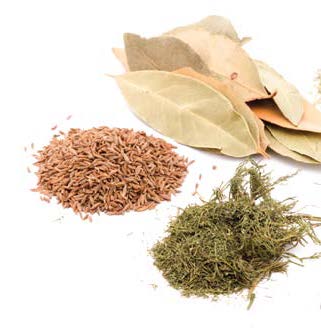The Well-Stocked Pantry
Having a variety of ingredients on hand makes cooking possible anytime. Our friends are often surprised how we can make dinner so quickly, even at the last minute. We know the secret is to have a few basic ingredients at home and a few good recipes to choose from.
 Herbs and Spices A bouquet of fragrant basil, a bunch of fresh parsley or sage and fresh-picked rosemary are some basic herbs found in our kitchens. They contribute important flavors and aromas to cooking. For best results, use fresh herbs when possible.
Herbs and Spices A bouquet of fragrant basil, a bunch of fresh parsley or sage and fresh-picked rosemary are some basic herbs found in our kitchens. They contribute important flavors and aromas to cooking. For best results, use fresh herbs when possible.
Spices have been used for centuries for their unique flavors and medicinal qualities. Salt and pepper are the most universal. Sea salt is obtained by evaporating seawater and has a “sweeter” flavor than table salt, which is pure sodium chloride. We suggest using sea salt in most recipes. Freshly ground black pepper is one of the most common spices in European cuisine. Black peppercorns are the most familiar, but red, green and white ones impart slight taste differences that are worth trying.
In the Fridge Refrigerator temperature has to be 38-40°F. Any higher than this is considered a “danger zone”. At danger zone temperatures, bacteria grow rapidly in perishable foods such as meat, poultry, fish, milk and eggs.
 Follow these simple suggestions to make sure your foods stay fresh, flavorful and safe:
Follow these simple suggestions to make sure your foods stay fresh, flavorful and safe:
- Divide large amounts of hot food into small containers (no more than 3" deep) before putting them in the fridge. Large batches of hot food will not chill fast enough to remain safe.
- Foods should be refrigerated within 1 hour to help prevent bacteria growth.
- Store foods in well-sealed containers or resealable plastic bags.
- Allow room between containers so cold air can circulate evenly.
- If the electricity goes off, do not open the fridge or freezer door.
- If raw food has leaked in the refrigerator or freezer, wash the area with hot soapy water and sanitize with chlorine bleach.
Never taste perishable food to determine if it is still good. The way that food smells or looks is not a reliable indicator of its safety. Harmful bacteria can multiply in food without causing an “off” smell or taste. Throw it out if you are not sure.

